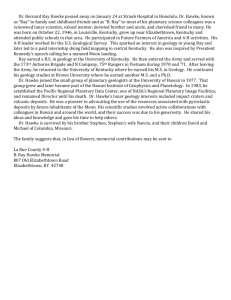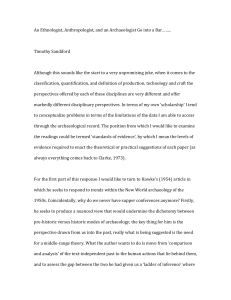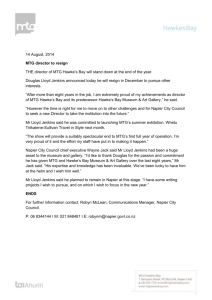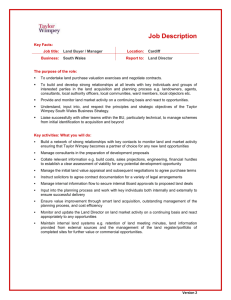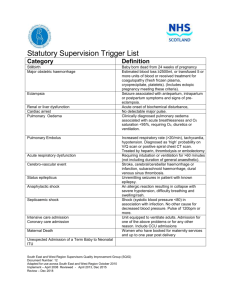HAWKE Anne Elizabeth
advertisement
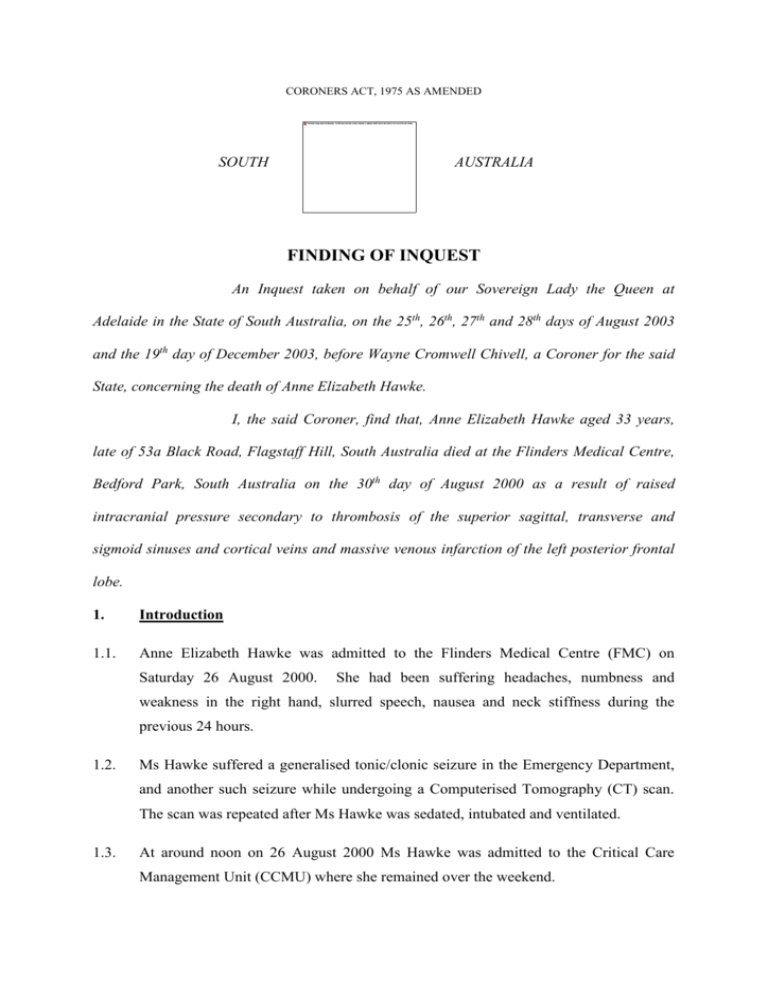
CORONERS ACT, 1975 AS AMENDED SOUTH AUSTRALIA FINDING OF INQUEST An Inquest taken on behalf of our Sovereign Lady the Queen at Adelaide in the State of South Australia, on the 25th, 26th, 27th and 28th days of August 2003 and the 19th day of December 2003, before Wayne Cromwell Chivell, a Coroner for the said State, concerning the death of Anne Elizabeth Hawke. I, the said Coroner, find that, Anne Elizabeth Hawke aged 33 years, late of 53a Black Road, Flagstaff Hill, South Australia died at the Flinders Medical Centre, Bedford Park, South Australia on the 30th day of August 2000 as a result of raised intracranial pressure secondary to thrombosis of the superior sagittal, transverse and sigmoid sinuses and cortical veins and massive venous infarction of the left posterior frontal lobe. 1. Introduction 1.1. Anne Elizabeth Hawke was admitted to the Flinders Medical Centre (FMC) on Saturday 26 August 2000. She had been suffering headaches, numbness and weakness in the right hand, slurred speech, nausea and neck stiffness during the previous 24 hours. 1.2. Ms Hawke suffered a generalised tonic/clonic seizure in the Emergency Department, and another such seizure while undergoing a Computerised Tomography (CT) scan. The scan was repeated after Ms Hawke was sedated, intubated and ventilated. 1.3. At around noon on 26 August 2000 Ms Hawke was admitted to the Critical Care Management Unit (CCMU) where she remained over the weekend. 2 1.4. Further investigation of Ms Hawke’s condition in the form of Magnetic-Resonance Imaging (MRI) took place on Monday 28 August 2000. 1.5. After further investigation on Tuesday 29 August 2000, Neurosurgeon Associate Professor Brian Brophy performed a decompressive craniotomy, after which anti-coagulation therapy was commenced. 1.6. Unfortunately, Ms Hawke’s condition continued to deteriorate to the extent that brain death was certified on Wednesday 30 August 2000. 2. Cause of death 2.1. A post-mortem examination of the body of the deceased was performed by Dr Suchitra Somers, Registrar, under the supervision of Dr Anna Simpson, Anatomical Pathologist, on 31 August 2000. 2.2. Following receipt of a full neuropathological analysis by Professor Peter Blumbergs of the Institute of Medical and Veterinary Science, Dr Simpson diagnosed the cause of death as: '1. Massive haemorrhagic venous infarction of left posterior frontal lobe. 2. Thrombosis of the superior sagittal, transverse and sigmoid sinuses and cortical veins. 3. Raised intracranial pressure with tonsillar necrosis and secondary haemorrhages in the rostral brain stem.' (Exhibit C3b, p1) 2.3. The clinicopathological correlation prepared by Drs Somers and Simpson is as follows: 'Anne Hawke was a 33 year old woman who suffered a massive venous infarction and gradually deteriorated. Craniotomy was performed to reduce intracranial pressure; however she continued to deteriorate and subsequently died. Autopsy findings showed marked cerebral oedema, cerebellar tonsillar notching and uncal herniation in keeping with raised intracranial pressure. Thrombosis of the superior sagittal, transverse and sigmoid sinuses and cortical veins was identified with a haemorrhagic infarction of the left posterior frontal lobe. Predisposition to such venous thrombosis arise due to a variety of factors, such as dehydration, oral contraceptive use or pre-existing hypercoagulable disorders. There was no evidence of pregnancy or history of preceding surgery in this case. 3 Anne Hawke died as a result of raised intracranial pressure secondary to thrombosis of the superior sagittal, transverse and sigmoid sinuses and cortical veins and massive venous infarction of the left posterior frontal lobe.' (Exhibit C3b, p2) 2.4. A ‘thrombus’ is a blood clot within a blood vessel which in this context may cause a blockage of that vessel leading to leakage of blood into the surrounding tissue (‘haemorrhage’), and the resulting pressure may result in ‘infarction’ or death of the tissue. 3. Background 3.1. The clinical record (Exhibit C4b) records that Ms Hawke attended at the FMC Accident and Emergency Department at 9:27 am on 26 August 2000. She was seen by Dr Gerrard who noted a history of right-sided headaches, weakness and numbness in the right hand, slurred speech, nausea and neck stiffness. Dr Gerrard also noted that Ms Hawke had been taking the oral contraceptive pill, and that she had taken two aspirin tablets at 7:00am. 3.2. Ms Hawke suffered a ‘generalised tonic/clonic seizure’ in the Accident and Emergency Department, after which she was unable to verbalise at all. Dr Gerrard arranged for her to be transferred to the Radiology Department for a CT scan because he suspected, correctly as it turned out, that she may have suffered an intra-cerebral haemorrhage. 3.3. The CT scan was taken under the supervision of Dr Evelyn Kat, a Senior Registrar in Radiology, at 10:29am. While the scan was being taken Ms Hawke suffered another seizure which caused her head to move, thus affecting the quality of the scan. 3.4. Dr Kat decided that a further scan was necessary. She arranged for Ms Hawke to be sedated, paralysed, intubated and ventilated to prevent further movement. 3.5. Dr Kar Who Ng, a Registrar in the CCMU, was called and he supervised Ms Hawke’s intubation and ventilation. A second set of scans was taken at 11:18am. 3.6. The topic of how the information obtained from these two sets of scans was transferred to the clinicians involved with Ms Hawke’s care was the subject of considerable debate during the inquest. It is an important issue and, as I will presently 4 discuss, it may have had a serious causative effect on the tragic outcome of Ms Hawke’s illness. 3.7. Dr Kat reviewed the CT films with Dr Peter Downey, the Radiology Consultant on-call that weekend, in either the late morning or early afternoon (Kat T118, Downey T47). Dr Kat dictated her report as follows: 'Report: On the initial scan, focal areas of haemorrhage was noted in the grey/white junction within the left parietal lobe, with surrounding oedema. Following intubation a repeat pre and post IV contrast scan was performed. This has shown progression of the haemorrhage, and haemorrhagic region covering approximately 2.2cm in the axial plane. There is further oedema and mass effect, with overlying sulcal effacement of the vertex. Peripheral curvilinear enhancement noted in this region. There was no intraventricular extension, ventricles are symmetrical. There is no evidence of midline shift. No other focal areas of haemorrhage are noted. No other abnormality was seen, with no evidence of intra or extra-axial mass lesion. Impression: Focal peripheral haemorrhage within the lateral lobe with mass effect, with curvilinear peripheral enhancement. Possible causes for this include an underlying vascular malformation, ie. cavernoma. Underlying mass, ie. neoplasm, cannot be excluded. The region appears quite focal for a venous infarction. Peripheral aneurysm is a possibility, ie. morcotic. Follow up imaging via MRI is recommended as clinically indicated.' (Exhibit C6, Annexure PRD1) 3.8. The particularly significant features of that report are: There was more than one area of haemorrhage; There was surrounding oedema; The haemorrhage had progressed in the 50 minutes or so between the two sets of scans (in fact a view of the films indicates that it had almost doubled in size); The amount of oedema had also increased between the scans with mass effect and overlying sulcal effacement (ie the ‘folds’ or sulci in the brain surface had effaced or disappeared, as a result of the swelling); There was no ventricular distortion, or midline shift between the two hemispheres; The possible causes of Ms Hawke’s condition were: Cavernoma; Tumour (neoplasm); Mycotic aneurysm; 5 Venous infarction (although the area appeared ‘quite focal’ and so this did not seem likely to the radiologists); A follow-up MRI was recommended. 3.9. Dr Kat’s verbal report was recorded on a Lanier computer system, and could have been accessed by the clinicians if necessary. It was typed onto the computer system later in the afternoon, but not printed into ‘hard’ copy until after 10:49am the next day when Dr Downey ‘authorised’ it with some inconsequential changes (Exhibit C6, Annexure PRD2). 3.10. Although it cannot be established conclusively, it seems likely on the evidence that none of the clinicians read the radiologist’s report. Instead, communication of the CT scan results took place orally: Dr Ng said that he discussed the results with Dr Kat after the CT scans were taken. He transposed what she told him to the clinical record, which reads (the interpretations in brackets are mine): 'I/C (intracerebral) bleed 2º to ? tumour ? mycotic aneurysm ? AVM (arterio-venous malformation, or cavernoma) Plan Await neurological opinion Blood cultures Dexamethasone' (Exhibit C4b) Note that Dr Ng did not note venous infarction as one of his differential diagnoses, nor did he mention the recommendation of a follow-up MRI; Dr Kat did not recall speaking to Dr Ng at all. She said that she spoke to Dr David Durham, the CCMU Senior Registrar (who was senior to Dr Ng), and told him the results, and that the she recommended a follow-up MRI; Dr Durham said that he had no memory of any such discussion (Exhibit C4f, p3). Dr Durham has left Australia since these events, so he could not be called to give evidence; 6 Dr Kat said that she also discussed the results with Dr Rahul Lath, the Senior Registrar in Neurosurgery who was rostered to provide neurosurgical cover for both FMC and the Royal Adelaide Hospital (RAH) that weekend. Dr Kat said that she spoke with Dr Lath between the 10:29am scan and the 11:18am scans; Dr Kat’s evidence about that is supported by the fact that Dr Lath’s note of the CT scans, which he made later in the afternoon, reads: 'CT: left posterior frontal: cortical/subcortical bleed 1.5 x 1 cm no mass effect or midline shift possibilities: 1) Cavernoma 2) Small AVM 3) Tumour with bleed' (Exhibit C4b) This note is consistent with the 10:29am scan but not with the 11:18am scans, when the important evidence that the size of the haemorrhage had increased markedly, as had the extent of the oedema, became evident. Dr Lath made no note of the MRI recommendation either. 3.11. Dr Ng telephoned Dr Lath, who had gone to the RAH, at about 12:50am. His note of the conversation is as follows: 'd/w (discussion with) Neurosurgery (Dr Lath) - not for O/T (operating theatre) at this time - control seizures and extubate - ? MRI on Monday (Exhibit C4b) 3.12. Dr Lath has also left Australia since these events and could not be called to give evidence. He told Detective Senior Constable Brown on 23 July 2002 that he attended FMC again at about 3pm that afternoon and examined Ms Hawke and saw both sets of CT scans (Exhibit C4h, p4). As I said, I doubt this. If Dr Lath did see the 11:18am films, he failed to appreciate the significance of the changes evident in them. 3.13. Dr Lath telephoned Associate Professor Peter Reilly who was the on-call Consultant Neurosurgeon that weekend. Associate Professor Reilly is the Director of Neurosurgery at the RAH. Associate Professor Reilly told me that Dr Lath outlined the history, and told him that Ms Hawke had undergone a CT scan, which indicated 7 that it was a small haemorrhage, there was no midline shift, that it was in the expected area having regard to Ms Hawke’s symptoms of right-sided weakness, and that the haemorrhage did not appear life-threatening. In particular, Associate Professor Reilly was reassured that the haemorrhage was quite small so that it was ‘not a matter of immediate neurosurgical concern’. He said: 'The particular issue that I was concerned about was whether it was haemorrhage from an aneurysm or a haemorrhage large enough to be of a threat to her well-being and so those situations did not appear to exist and we considered therefore that she’d had a haemorrhage from some undiagnosed cause that it could be a small vascular malformation, it could be a tumour, or it could be what’s called an arterio venous malformation. However the conclusion was that at this stage the cause of the haemorrhage was undiagnosed, that she was not in immediate danger, that she would need further investigations.' (Exhibit C9a, p4-5) 3.14. Associate Professor Reilly said that he advised Dr Lath to arrange for Ms Hawke to be extubated, and that she should be allowed to wake up so that her neurological state could be assessed, that her seizures should be controlled, and that she should be closely observed. He suggested that a non-urgent MRI should be performed on Monday (Exhibit C9a, p7). 3.15. Associate Professor Reilly was very clear that Dr Lath did not tell him that Ms Hawke had undergone two sets of scans, that the haemorrhage had progressed markedly between the two scans, or that there was evidence of mass effect and sulcal effacement in the second scans, or that the radiologist had recommended follow-up MRI scans (T179). He said that if he had received this information, he would have been more concerned that Ms Hawke’s condition was progressive, and that there was a need for more immediate investigation. In particular, he said that he would have attended at FMC and examined Ms Hawke, reviewed the history and the radiology (T196). 3.16. Dr Lath examined Ms Hawke again during the morning of 27 August 2000. He noted that she ‘opens eyes spontaneously’ and ‘obeys commands’. condition as ‘stable’ (Exhibit C4g, p8). He regarded her 8 3.17. Ms Hawke was extubated at 12:00 noon on 27 August and her sedation was ceased. The nursing note reads that she ‘communicates by squeezing (L) hand to answer questions’. 3.18. Dr Lath telephoned Associate Professor Brian Brophy that evening. He is the Director of Neurosurgery at Flinders Medical Centre. He said that, since he was not on-call, it is likely that Dr Lath may have called for another reason, and told Associate Professor Brophy about Ms Hawke’s case incidentally. In any event, he did not clearly recall what Dr Lath told him, except that Ms Hawke was to have an MRI on Monday. 3.19. Associate Professor Brophy was operating at the RAH on Monday 28 August 2000. He said that he telephoned Dr Lath during operations, and was surprised that the MRI had not been done (T154). He telephoned again at around 4pm, and Dr Lath told him: '… that I needn’t concern myself about the patient any more, that the family had requested the involvement of Professor Jones and so I said “okay, that’s fine”.' (Exhibit C8a, p2) 3.20. It transpired that Ms Hawke’s family had requested Professor Nigel Jones, the Director of Neurosurgery Research at the RAH, to examine her, but he was unable to see her until Thursday 31 August 2000. Dr Lath did not tell Associate Professor Brophy that. Associate Professor Brophy was surprised that he did not do so, and said that he would have seen Ms Hawke on Monday 28 August if he had known (T156). 3.21. A MRI scan was eventually taken on 28 August 2000. The report reads: 'Findings: The lesion in the left powered temporal lobe has expanded remarkably compared to the CT of just 2 days ago. The lesion now extends to the vertex superiorly and occupies up to 1 half of the volume of the cerebral hemisphere. It is associated with much mass effect compression of the lateral ventricles and midline shift. The lesion shows peripheral oedema and there is now a large centre which is hypo to isointense on T1 and hypointense on T2 consistent with acute haematoma. There was no abnormal enhancement on the Gadolinium images to suggest an underlying vascular malformation or tumour. The MRA demonstrates normal and patent proximal vessels with no focal thrombosis or occlusion. The MRV shows the superior sagittal sinus from vertex to confluence. I believe it is patent further anteriorly based on the coronal images. The basal vessels including the inferior sagittal sinus, straight sinus and internal cerebral veins are note well demonstrated and this may reflect compression of these vessels due to the midline shift and oedema. Again however I suspect they are patent based on the axial images. 9 Conclusion: There has been further evidence of a large intracerebral bleed with a resulting haematoma, oedema and midline shift. The combined sequences do not suggest there is an underlying vascular malformation or tumour.' (Exhibit C4b) 3.22. Dr Lath said that he discussed the results with Dr Kat, although he still did not think that Ms Hawke was suffering from a venous occlusion (Exhibit C4g, p10). This is difficult to reconcile with Dr Kat’s evidence that the MRI excluded the diagnosis they thought most likely, ie. an AVM or cavernoma, a haemorrhagic tumour, or a mycotic aneurysm, which really left the diagnosis as venous infarction by default (see also the evidence of Dr Downey at T79). 3.23. Dr Lath said that he discussed these results with Associate Professor Brophy during the 4pm telephone conversation, and that Associate Professor Brophy said that he would review the films the next morning at the radiology meeting (Exhibit C4g, p11). Associate Professor Brophy said he had no memory of such a discussion (T157). 3.24. At 8am on Tuesday 29 August 2000 Dr Kat presented Ms Hawke’s case to the weekly meeting between the Radiology, Neurology and Neurosurgery departments at FMC. Associate Professor Brophy concluded, on the basis of Ms Hawke’s clinical state, which by this time was critical, the CT scans and the MRI scan that Ms Hawke had a veno-occlusive problem. 3.25. Having formed that opinion, Associate Professor Brophy directed that Ms Hawke should have a repeat CT scan and a cerebral angiogram. 3.26. The CT scan was performed at 10:28am, and the report reads: 'There has been marked increase in the size of the left parietal lobe haemorrhage, with surrounding oedema and significant mass effect causing deviation of midline structures to the right of approximately 2cm. There is generalised sulcal effacement. There is mild compression of the left lateral ventricle, the right ventricle deviation slightly more to the right, with prominence of the right temporal horn due to a degree of obstruction. There is reduced CSF (cerebro spinal fluid) in the basal cisterns.' (Exhibit C4b) 3.27. The Magnetic-Resonance Angiogram (MRA) was performed at 11:35am. The report reads: 'FINDINGS: Selective internal carotid injection reveals no major arterial occlusion within the anterior circulation on either side. The venous phase images show a small 10 segment of the superior sagittal sinus close to the vertex which partially fills with contrast and this could reflect non-occlusive venous thrombus. As discussed prior to the procedure, the status of the cortical veins could not be conclusively determined by this technique. Selective left external carotid injections revealed no evidence of an AV fistula but prominent superior ophthalmic flow was present. CONCLUSION: Probably filling defect superior sagittal sinus close to the vertex. The appearances suggest partial occlusion due to thrombus. The status of the cortical venous system could not be clarified.' (Exhibit C4b) 3.28. Having his opinion confirmed by these further investigations, Associate Professor Brophy performed a decompressive craniotomy in order to reduce the intracranial pressure, which was achieved. The CT scan was repeated and established that there had not been a re-accumulation of blood clot. Anti-coagulation therapy in the form of Heparin was then commenced. 3.29. Unfortunately, Ms Hawke’s condition continued to deteriorate, to the extent that brain death was eventually certified by Dr A Vedig at 1:15pm on 30 August 2000, and confirmed by Professor A Bersten at 3:35pm that day. 4. Issues arising at the inquest 4.1. I had the assistance of an assessment of the clinical care given to Ms Hawke by Dr Jeremy Hallpike, a very experienced Neurologist. 4.2. Dr Hallpike’s analysis was initially complicated by the fact that after Associate Professor Brophy formed his diagnosis on Tuesday 29 August 2000, Dr Downey completely rewrote the report of the CT scans taken on 26 August 2000, the report which he had authorised on 27 August 2000. Dr Downey’s rewritten report reads: 'Report: On the initial scan, patchy haemorrhage was noted at the grey/white junction within the left parietal lobe, with surrounding oedema. Scans obtained following intubation show progression of the haemorrhage which now involves cortex as well. The haemorrhagic region covering approximately 2.2cm in the axial plane. There is further oedema and mass effect, with overlying sulcal effacement of the vertex. Subtle peripheral curvilinear enhancement may be present in this region. There was no intraventricular extension, ventricles are symmetrical. There is no evidence of midline shift. No other focal areas of haemorrhage are noted. No other abnormality was seen, with no evidence of intra or extra-axial mass lesion. 11 Impression: Possible causes for this haemorrhagic process include venous infarction, haemorrhagic ischaemic infarction and vasculitis. An underlying lesion, eg malformation, aneurysm or neoplasm is considered less likely. Follow up MRI is recommended.' (Exhibit C6, Annexure PRD3) 4.3. I accept that Dr Downey’s actions in rewriting the report were innocent and not an attempt to mislead. However, it was, in my opinion, quite inappropriate to rewrite the report, rather than adding an addendum to it which would have made the diagnostic history clear. For example, the earlier report described the haemorrhage as ‘too focal and dense for a haemorrhagic infarction’, whereas the rewritten report describes the haemorrhage as ‘patchy’, and gives venous infarction as the first differential diagnosis. 4.4. Having received the material, Dr Hallpike commented: 'Comments Diagnosis Spontaneous cerebral venous thrombosis continues to be regarded as a rare clinico-pathological entity. There is a very well recognised association between CVT and the puerperium. Otherwise in the literature, until fairly recently the diagnosis of CVT has been regarded as frequently being elusive in the early stages of the condition. A recurring theme in this regard is the need for clinical awareness of the condition. Given this and ready availability of neuroimaging, particularly MRI, CVT is now almost certainly being more frequently diagnosed and treated. … Cerebral angiography has traditionally been held to be the definitive diagnostic procedure for the diagnosis of sagittal sinus thrombosis. However, since the advent of CT and MRI scanning, there have been numerous single and multiple case studies setting out the value of these investigations in achieving earlier diagnosis by non-invasive means and generally reporting on benefits of anticoagulant therapy. The presenting clinical features in this case, namely the initial headache, the succeeding focal (referable to localised cerebral pathology) neurological deficit symptoms and the seizures, are typically encountered in CVT but are not pathognemonic (exclusive to this causation). The initial clinical differential diagnosis of such an actual focal cerebral presentation in an apparently previously healthy person of this age is wide, and includes a bleed from an AVM, herpes simplex encephalitis, cerebral tumour, spontaneous (idiopathic) cerebra haemorrhage, stroke, haemorrhagic leucoencephalitis and CVT. It would be expected to narrow this down very quickly with the assistance of imaging and other investigations. Identification of a thrombosed cerebral venous sinus by brain imaging, cerebral angiography, or autopsy is regarded as necessary for a definitive diagnosis of CVT. … Management the early neurosurgical management of intracerebral haemorrhage is generally conservative. There have been major clinical trials that have shown that early 12 operative evacuation of blood clots (haematoma) from the cerebral hemispheres offers no outcome advantages over conservative management (intensive nursing, treatment for cerebral oedema, treatment of seizures if applicable, pari passu with continuing reevaluation and investigation). In this case, however, the young age (33), gender, known fact of being on the contraceptive pill, and the initial CT scan appearances of haemorrhagic process with oedema (favouring haemorrhagic venous infarction rather than a haematoma), taken together pointed to an initial need for a wider differential diagnosis, including CVT, than was set out in the hospital notes and acted on. For such reasons, neurological consultation or review by an experienced consultant physician on the day of admission would have been appropriate.' (Exhibit C10a, p3-4) 4.5. In a later report, Dr Hallpike added: 'In keeping with my original report, I wish to note that, in my opinion, criticism relates to so much to the fact that the CVT diagnosis wasn’t, and may still not have been, made over the weekend, but rather that her diagnosis wasn’t vigorously pursued while there were still some prospects of getting on top of the problem, and that no emergency medical neurological input was sought.' (Exhibit C10c, p2) 4.6. Dr Hallpike told me in oral evidence that in Ms Hawke’s case, a young woman with a critical neurological condition which was still developing on 26 August 2000, the clinicians were faced with a ‘major diagnostic problem’, and that the investigative process on that day should not have stopped until a diagnosis was reached (T206). As it transpired, the MRI was somewhat inconclusive, although it did serve to exclude some of the more favoured differential diagnoses. MRI Angiography should then have been performed, and this should have led to the correct diagnosis. If not, then cerebral angiography was the next step (T207). 4.7. Dr Hallpike noted that the disease in Ms Hawke’s case pursued an ‘unusually aggressive course’, but that the literature suggests that her chances of survival could have improved from a mortality rate of 69% to 15% with early Heparin therapy (Exhibit C10a, p6). 4.8. Both Associate Professor Brophy and Associate Professor Reilly acknowledged that there had been a failure to pursue a diagnosis with sufficient vigour over the weekend of 26 and 27 August 2000 (T164, T191). 4.9. It is always difficult, if not impossible, in these cases to isolate a single critical cause for such a failure. The clinicians receive a variety of input, from radiology, 13 conversations with colleagues, advice from consultants, their own experience as well as the patient’s clinical presentation. At any stage in the diagnostic process, a wrong turn can be taken which can lead to tragic results. 4.10. I will attempt to identify a few factors here which I consider influenced the outcome: The decision, presumably made in the CCMU although that is not clear, to refer Ms Hawke’s case for neurosurgical rather than neurological advice. Dr Hallpike pointed out that the core business of a neurologist is as a diagnostician, and that there were many differential diagnoses of Ms Hawke’s condition on 26 August 2000 which were not considered. When only a few neurosurgical alternatives were considered, an inappropriate decision to manage Ms Hawke conservatively was the result (T210-212); There was a breakdown in communication between the radiologists and the neurosurgeons, as a result of which Dr Lath gave a completely inadequate picture of Ms Hawke’s condition to Associate Professor Reilly. It would appear that Dr Lath did not read the written radiology report at all, and only read the first CT scan and not the second. Had Associate Professor Reilly been told the full extent of the problem, I think that he would have attended at FMC on 26 August 2000, an MRI and then MRA would have been performed that day, and that the correct diagnosis would probably have been reached; There is a bewildering number of permutations of the conversations that allegedly took place between the health professionals on 26 August 2000. In almost every case, one participant in the conversation cannot remember the conversation, while the other participant remembers it in detail. It would be futile to require that all such conversations should be recorded in detail in the clinical record. However, it is necessary that the communication between professionals in such highly technical areas must be improved to avoid the egregious errors which occurred in this case; The Radiologists, Dr Kat and Dr Downey, both conceded that they failed to diagnose CVT from the initial CT scans. Neither had seen such a case before, and Dr Downey is a very experienced Consultant Radiologist. There was no criticism of this non-diagnosis, however, because angiography is normally regarded as the definitive diagnostic tool and this was not performed until Tuesday, 29 August 14 2000. The plain fact is that the Radiologists recommended a follow-up MRI scan, and this was not acted upon. Dr Kat said that she regretted adding the rider ‘as clinically indicated’, as it may have made the recommendation appear less urgent (T132). I think that the rider was appropriate, as the clinical picture suggested than an MRI investigation was urgent anyway. In any event, it does not appear that the clinicians read the radiology report. Dr Hallpike said that the radiologists would have benefited from the advice of an experienced neuro-radiologist (T224); It is clear that in August 2000 CVT was a rare condition the diagnosis of which was often missed. Associate Professor Brophy told me that in his experience even in cases where the diagnosis had been made it was commonly delayed (T161). Associate Professor Reilly told me that he had never seen the condition before in the form Ms Hawke presented with, that is a spontaneous thrombosis, although he had seen it in the context of trauma or the aftermath of surgery (T190). The radiologists Drs Kat and Downey had never seen it, nor had Dr Ng (T33). I was informed, and accept, that there is a much higher level of awareness of this condition since Ms Hawke’s death, such an increase in awareness being concomitant with a general improvement in diagnostic rates as a result of developments in imaging, particularly with CT and MR scanning; It was suggested by Mr Lewis Hawke, brother of the deceased, that Consultants should always examine a patient under the care of their department, rather than relying on the assessment of a registrar. I do not accept this argument. It is not feasible to expect a Consultant to attend the hospital every time there is a change or development in a patient’s condition. Dr Lath was not an inexperienced intern. He was a Senior Registrar, a fully qualified Neurosurgeon in India, and a person who had impressed both Associate Professor Reilly (T187) and Associate Professor Brophy (T151) with his competence and reliability. Of course the Consultant is ultimately responsible for the patient’s treatment, but in the discharge of that responsibility he is required to form a judgment about whether to rely upon the assessment of an experienced registrar, as Associate Professor Reilly did. I do not think he can be validly criticised for that. Factor V Leiden is a hereditary genetic condition which predisposes a person to thrombosis. It was not known until after Ms Hawke’s death that she carried this genetic condition. Dr Hallpike told me that a woman, by taking the oral 15 contraceptive pill (OCP), multiplies the risk of thrombosis by a factor of 3 to 4, but the factor can be as high as 30 in a person with the Factor V Leiden gene (Exhibit C10a, p5 and T215). In view of that, I asked whether it was routine practice to screen women taking the OCP for Factor V Leiden. I have, since the oral evidence closed, received some advice from Dr Chi-hung Hui, a Haematologist at the South Australian Institute of Medical and Veterinary Science. Dr Hui advised that Factor V Leiden is present in 5% of the white female population, and that of women who proved positive, approximately 20,000 would be denied use of the OCP to prevent one death. In order to find those 20,000 women, 400,000 women would need to be screened. Dr Hui advised: 'At a British College of Pathologists symposium in 1997, it was suggested by the experts in this field that “For the time being, it may be more logical and practical to limit screening of young girls for Factor V Leiden prepregnancy or before prescribing OC to those who have a personal or family history of venous thromboembolism”.' I accept that advice. 5. Conclusions 5.1. Taking all that evidence into account, I find that Ms Hawke’s death was caused by raised intracranial pressure secondary to thrombosis of the superior sagittal, transverse and sigmoid sinuses and cortical veins and massive venous infarction of the left posterior frontal lobe. 5.2. I find that Ms Hawke’s condition should have been investigated more thoroughly following her admission to FMC on Saturday, 26 August 2000, and that those investigations should have continued until a clear diagnosis was reached. 5.3. If the investigations had been more thorough, it is likely that a CVT would have been diagnosed, and the early commencement of Heparin therapy would have reduced the mortality likelihood from 69% to 15%. 16 5.4. The failure to investigate Ms Hawke’s conditon ws brought about by a number of factors, including: The non-involvement of an experienced Neurologist; Dr Lath’s failure to read the radiology report, and to see the second CT scan and appreciate its significance, as a consequence of which follow-up investigations were not performed; Dr Lath’s failure to brief Associate Professor Reilly adequately over the telephone as a result of which Associate Professor Reilly did not attend personally at FMC; The fact that Associate Professor Brophy did not become involved in Ms Hawke’s treatment until it was too late, because he was informed that Professor Jones had been asked to see her, but he was not told that Professor Jones would not see her until Thursday, 31 August 2000. 5.5. It is difficult to understand how these errors could have occurred. Ms Hawke was a young woman presenting with very serious symptoms, and yet the lack of urgency and general disorganisation associated with her treatment at FMC should be cause of great concern. 6. Recommendations 6.1. I am empowered by Section 25(2) of the Coroner's Act 1975 to make recommendations when I am satisfied that to do so would ‘prevent, or reduce the likelihood of, a recurrence of an event similar to the event that was the subject of the inquest’. 6.2. I recommend as follows: That the Flinders Medical Centre reviews its clinical practices and procedures to ascertain whether more could be done to ensure that communication between clinicians, and between clinicians and radiologists could be improved, that the appropriate specialties are involved in treatment, and that Consultants are adequately briefed before making decisions in relation to treatment; 17 That the Flinders Medical Centre Radiology Department ensure that written reports are maintained in their original state on the record, and that any changes should only be by way of addendum rather than rewriting the original report. That whenever medical practitioners prescribe the OCP, they should take a careful personal and family history to ascertain if there is any relevant history of thrombo-embolism. If so, the patient should be screened for Factor V Leiden, and, if positive, should be advised of the substantially increased risk of thromboembolism. Key Words: Hospital Treatment; Cerebellar Venous Thrombosis; Venous Infarction; Factor V Leiden In witness whereof the said Coroner has hereunto set and subscribed his hand and Seal the 19th day of December, 2003. Coroner Inquest Number 18/2003 (2239/2000)



